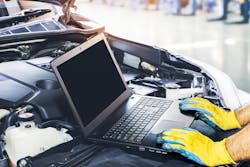Digital inspections are here and are going to play a significant part in successful shop futures. Shops that have already adopted these digital methods are reaping the benefits that are almost guaranteed by making this change. I say “almost guaranteed” because a shop needs to be committed to making them work.
In this article, I'm going to go over the basics of digital inspections for those of you who are considering making the leap. I hope that through what you read here, you will understand the power of digital inspections. These inspections will have a profound effect on your relationship with your customers by lowering the level of distrust they have for the automotive repair industry.
The first basic thing to consider about starting digital inspections is to know there is a learning curve. Like any other new process, you will need to slow down and learn at first. Many shops fear the slightest slowdown in their day-to-day operations, and this is one of the main reasons for the failure to adopt digital inspections. The point is that once this process becomes memorized and is used daily, it is going to boost the shop’s income across all levels for years to come.
Before beginning to use digital inspections, I recommend that a shop spend some downtime going over the benefits and the process. Additionally, show all who will be interacting with them how they actually work. Don’t just thrust tablets into your technicians’ hands and hope for the best. Take advantage of all the training available from each digital inspection provider. This training can be anything from live webinars to recorded videos.
Most digital inspection companies will provide you with a variety of inspection options. My recommendation is to choose the one as close to the paper inspection you may have been doing up to this point. Give the inspecting technicians guidance and time as they perform the first few inspections. Make it a point to go over the results of each inspection, so the technicians can adjust how they perform them as they move forward.
At first, have frequent shop meetings about how the inspections are going. Discuss the number and quality of pictures or videos taken. Review the recommendations and findings that techs are recording. Also, start noting changes that you’d wish to make to the inspection. Get feedback about changes from all the staff involved with the digital inspection process.
Many digital inspections allow the shop to either customize or create their own inspections. Using the results from these meetings, go into the inspection and modify it to include any suggestions they have made. If your digital solution allows it, you can start to build your ultimate inspection from scratch.
Use these modified inspections when ready and continue the process of noting what might need to be changed or added to each.
In the beginning, these meetings will cost the shop productivity and time, but ultimately, once the inspection has been adjusted and fine-tuned, your payback will occur every time the inspection is used. Also note that having all the staff involved with the process of instituting and changing the inspections gives them buy-in. Having that, they will be more apt to use the process of digital inspections, producing excellent results.
During these meetings, also discuss the quality of the pictures being taken. Stress that pictures should be taken not only of items that are worn or failed but also of those that are in good shape. This helps balance out the inspection and having these pictures will provide a wear history for the customer.
This will provide them with a recorded path of items wearing, from those in good condition to those needing to be serviced. In other words, your customers will be able to see the brake pad material wear-down through the pictures provided over time. This will help customers to mentally and financially prepare from when those brakes or tires need to be replaced and will reduce those surprise large repair bills.
Another benefit from creating a wear history for the shop is that the customer needs to come back to your shop for regular service in order to have the inspections done. Your shop is the only one that has access to these digital inspections showing the wear as it goes on.
Use these meetings to discuss what constitutes a good photograph of a failed item. Remember, our customers do not necessarily understand what we may be showing them in these pictures, so these pictures need to be clear for them to understand what we are sharing. Marking up the pictures with the available tools the digital inspection provides can further focus the customer’s eye on what we're trying to communicate to them.
Have metrics in place to measure the important aspects of digital inspection. Use these results at your meetings to help keep the team moving forward. Metrics include, but are not limited to:
- Percentage of eligible vehicles getting an actual inspection (Should be close to 100 percent)
- Numbers of photos used on each inspection (12 to 15 total seems to be a good number)
- Percentage of inspections sent to customers (There is no benefit if not sent)
- Percentage of customers who view the inspections (There is no benefit if not looked at)
Once the inspection process is flowing rather smoothly, you can cut down the frequency of the shop meetings. I recommend you do not completely eliminate them. Having meetings where people are responsible for what they're doing helps keep everybody on track, therefore giving the inspections further ability to have a positive impact.
To further ensure your shop’s success with digital inspections, you need to educate your customers about receiving and looking at them. Many inspections are sent to the customer via text message, so you need to inform your customers you will be communicating with them via text. It is important that you get your shop information into their contacts on their phone, so when you send a text, it displays your shop name and information letting the customer know the text message is in reference to their vehicle and not a spam message.
Some time should be spent educating the customers on the digital inspections that you will be sending to them. It is best to take them through the process of looking it over. Show them how they can navigate through it and tap on the pictures to enlarge them or even how they can turn on the slideshow, where they will automatically see the pictures displayed one at a time.
If the digital inspection has this option, show your customers the “learn more” videos and such to help educate them on the “why” of the recommended repairs or services. Don't forget to send these digital inspections even to your waiting customers, so you can show them all of the information that they display, too!
These are just a few of the basic steps to take to ensure that your shop gets the maximum return when moving to use digital inspections. Most importantly, do not get lost in the time it takes you to get your shop up and running smoothly with the inspection process. This investment will repay your shop every time an inspection is used to its fullest potential for years to come.
About the Author
John Burkhauser
John (JB) Burkhauser has 40-plus years of automotive experience to share. He attended tech school, grew up in dealerships, worked with independent shops, taught 10 years of post-secondary automotive, and trained shops on how to eliminate daily roadblocks to their service process. In his goal to help shops become more successful, he is published in numerous publications such as this one and gives regular webinars sharing what he knows works. Email him with any questions or comments.

